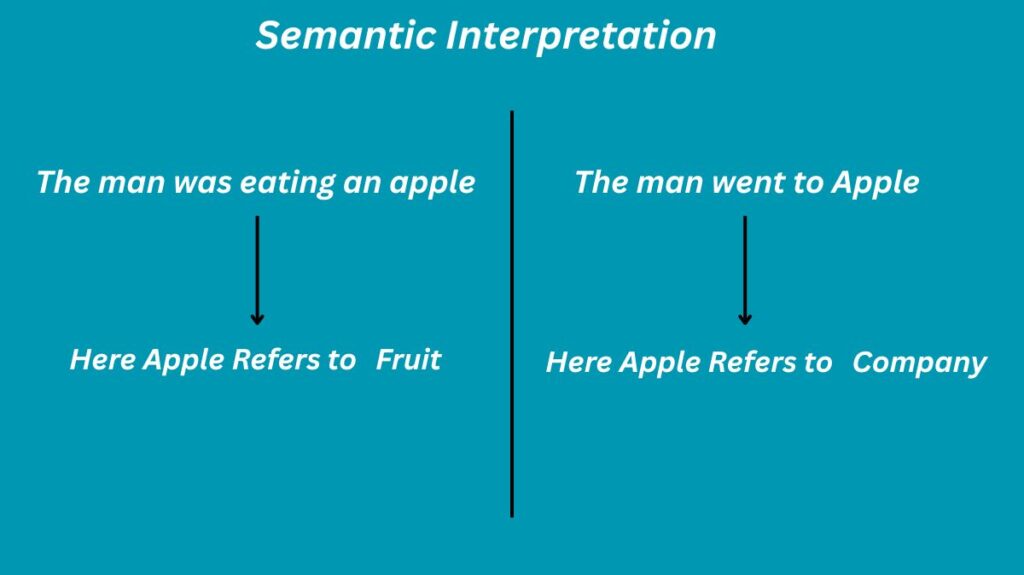Semantic Interpretation Meaning
Determining the meaning of text is the core task of semantic interpretation in Natural Language Processing (NLP). It is frequently seen as a stage that comes before pragmatic analysis and after syntactic analysis (parsing). Semantic interpretation’s main goal is to provide a computer-processable representation of the text’s meaning so that further calculations, manipulations, and searches may be made. Any system that wants to comprehend language or carry out language-based operations must have this representation. The ultimate objective is to develop a meaning representation that is both flexible enough to be used across many domains with little change and comprehensive enough for reasoning systems to make deductions.

Example
The word “bark” can mean “the sound a dog makes” or “the outer layer of a tree”.
Explanation
Semantic analysis, particularly word sense disambiguation, helps determine the correct meaning of “bark” based on its context within a sentence or text.
Semantic theory
A semantic theory that supports semantic interpretation should have several capabilities:
- Sentences with unclear meanings need to be explicable by it. Because “bill” can refer to either money or a bird’s beak, the line “The bill is large” is confusing.
- It should to be settle word ambiguities according to their context. When the phrase reads, “The bill is large but need not be paid,” the theory ought to clarify the word “bill” in terms of money.
- Sentences that are syntactically valid but have no meaning should be recognised by it. “Colourless green ideas sleep furiously” is given as an example.
- Despite possibly having distinct syntactic structures, it should be able to distinguish paraphrases with the same semantic meaning.
Key issues and components
During semantic interpretation, the following important topics and elements are covered:
Structural Ambiguity: The several alternative syntactic structures of a statement give rise to this type of ambiguity. To solve this, the statement must be converted into its underlying syntactic structure.
Word Sense Disambiguation (WSD): This is an essential element. It entails figuring out a word’s precise meaning or sense based on its usage in a particular context. Since the same word form might represent several things or concepts in various situations, WSD is required. For instance, “bank” might refer to a bank or a riverbank, while “nail” can refer to a portion of the body or a metallic thing. Both homonyms (unrelated senses) and polysemous words (related senses) require WSD.
The words themselves are usually the smallest pieces taken into consideration in a compositional approach, where the meaning of the whole is constructed from the meaning of the parts. The main proof of disambiguation is found in the context of a term. Word senses can be defined at several levels of granularity, ranging from clear homographs to more nuanced differences. One way to think of WSD is as a kind of semantic label tagging. Rule-based, knowledge-based, supervised, unsupervised, and semi-supervised techniques are among the approaches. In unsupervised and semi-supervised methods, heuristics such as “one sense per discourse” and “one sense per collocation” are employed.
Entity and Event Relation Identification: Another crucial aspect of semantic interpretation is determining the relationships between the things and events in a phrase. This covers assignments such as Semantic Role Labelling (SRL). SRL recognizes predicates’ arguments, which are usually the primary verbs, and ascertains the semantic function of each argument with respect to the predicate. Shallow semantic parsing is another name for SRL.
Meaning Representation: The creation of a semantic representation, also known as a meaning representation, is the ultimate result of semantic interpretation. For a variety of purposes, algorithms can modify this form, which is frequently referred to as a deep representation. A logical form is frequently used to abstract meaning representations.
Semantic interpretation approaches
Semantic interpretation approaches can differ in a number of ways:
Scope: A rich, domain-dependent representation can be produced by designing systems for a narrow, specialised domain (the first method). As an alternative, they can develop more versatile intermediate representations, the second of which calls for a translation layer for particular uses.
Coverage: For machine action, shallow systems generate an intermediate representation that requires further conversion. This includes shallow semantic parsing, or SRL. An application uses the terminal representation produced by deep systems directly.
Formal vs. Cognitive: Semantic representation theories fall into one of two general categories: formal or cognitive. Truth-conditional meaning is a common emphasis of formal theories, which are commonly inspired by philosophical logic. More recently, cognitive approaches which draw inspiration from psychology and cognitive science have gained popularity.
Compositional vs. Lexical: Lexical semantics, or the meaning of individual words and fixed expressions, and supralexical or compositional semantics, or the meaning of phrases and sentences derived from the combination of word meanings, are both included in semantic analysis. Semantic interpretation, which frequently begins with word meanings, constructs the meaning of the entire phrase. Despite their historical separation, word-level and grammatical semantics are now more widely acknowledged to interact. Lexical semantics is usually the first step in semantic analysis, which then looks at how word meanings mix in context.
The goal of semantic interpretation is to capture the meaning of natural language utterances by creating meaning representations (like logical forms). For this, a variety of formalisms are employed, including predicate-argument structures, Lambda calculus, and First-Order Logic (FOPC). The objective is to transition from natural language’s ambiguity to a clear representation suitable for computer applications. Model-theoretic semantics is a method that addresses the requirement to relate language to the outside world by connecting these representations to outside knowledge or world models. Translating phrases into a semantic metalanguage or representational system is the larger topic of semantic analysis.
